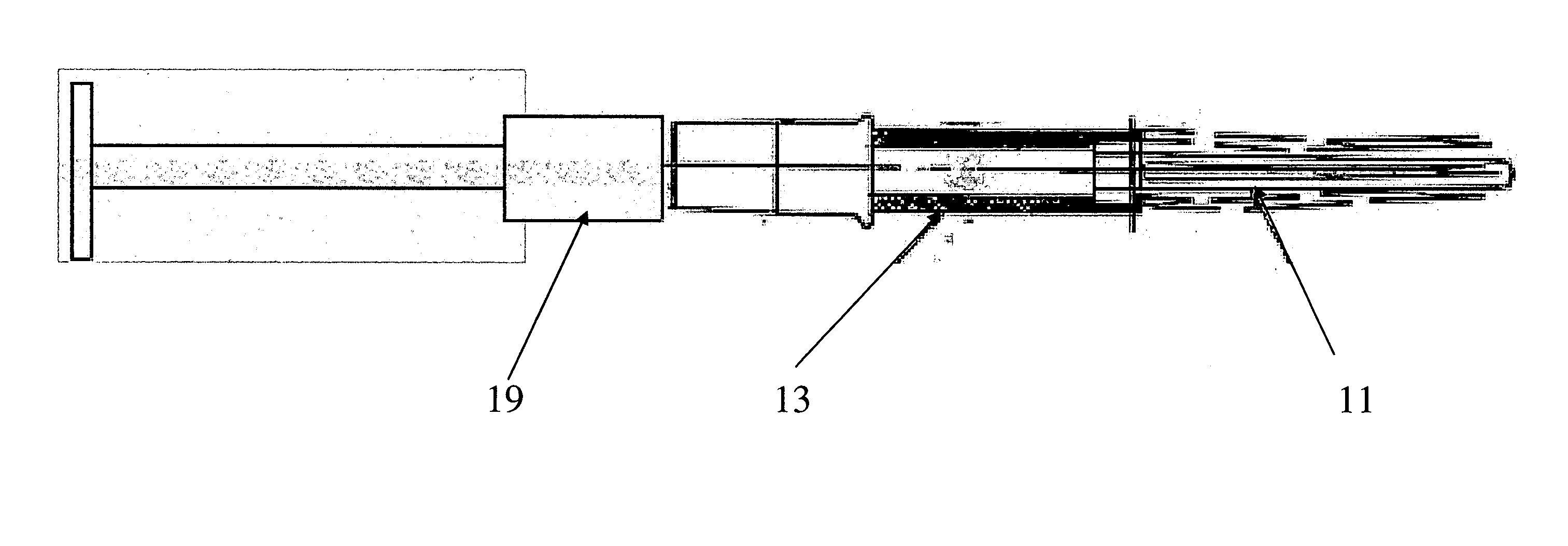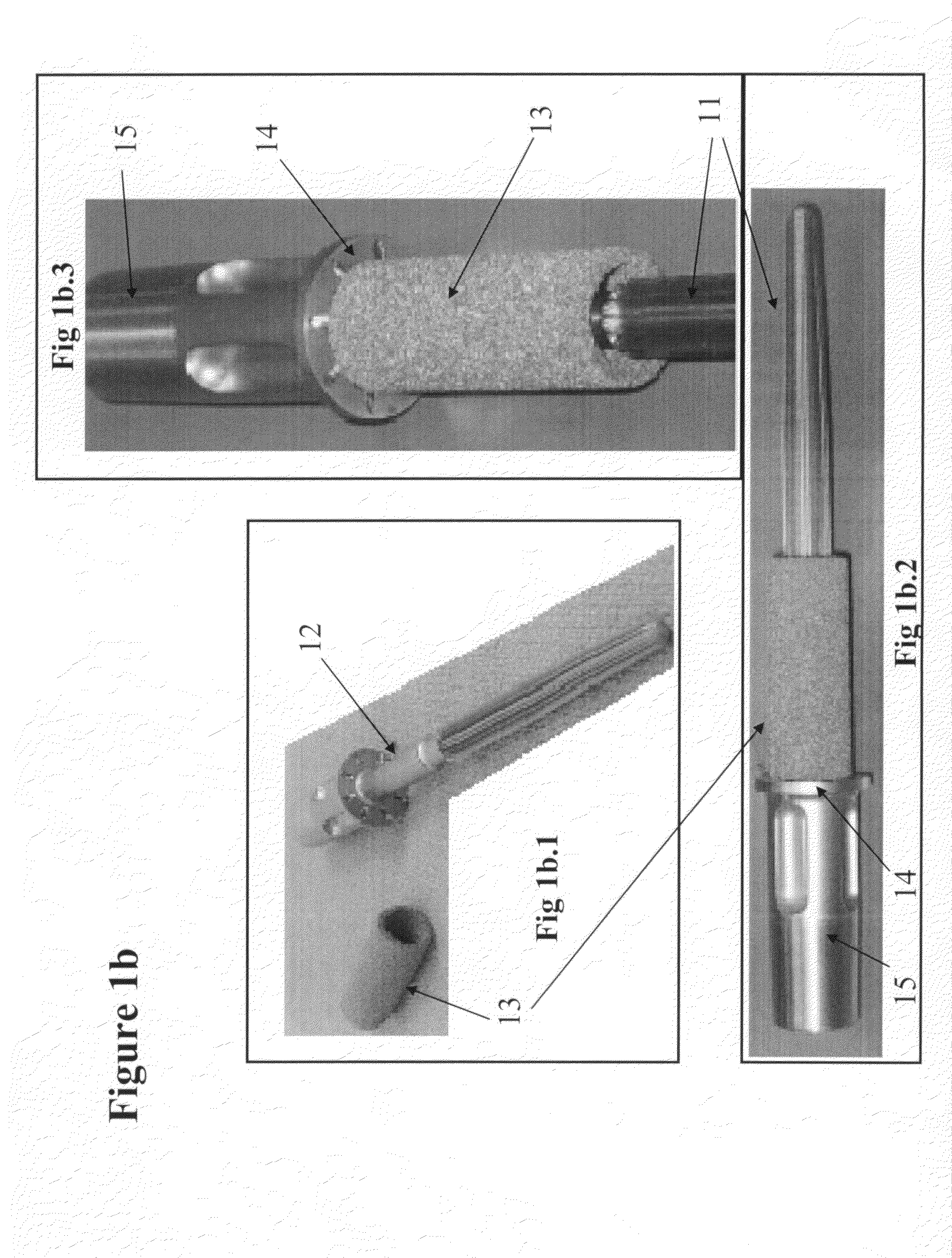[0026]Since the male tapered bone free end contacts the female tapered end of the porous outer body, the bone grows into the pores of the porous outer body forming biological attachment. This
bone growth may extend as much as 0.5 to 1 inch, converting the porous outer body to a composite of bone and
titanium while the press fit against the cylindrical portion of the inner core of the stem becomes tighter. Since the porous outer body also contacts the soft tissue over a significant distance, it tends to grow and enter the pores of the
metal porous body, creating biological attachment of the soft tissue to the same member, and providing biological attachment to the bone. This creates a stable natural attachment of the percutaneous implant, which resembles the native attachment of a
bone tissue to soft tissue. Since the skin is stitched around the suture ring, which is part of the stem, the latter, being made from the bio-compatible
metal alloy, promotes biological attachment of the skin to the suture ring.
[0027]Immediately after the surgical procedure of the percutaneous implant in an amputated limb, the implant is held in place by three key elements. First, the fluted tapered stem engages with the tapered fluted bone cavity prepared by the surgeon due to the force applied to the distal end of the stem. Secondly, the male tapered end of the bone engages the female tapered end of the porous metal outer body that is press fitted against the outer
diameter of the inner core portion of the stem, and at the same time rests against the suture ring. Thirdly, the soft tissue surrounds the outer surface of the porous metal outer body for a significant length and the skin is sutured, surrounding the surrounding suture ring. These attachment means secure the percutaneous implant against the
bone tissue and soft tissue and prevent any lateral or longitudinal movement, allowing both bone in-growth and attachment as well as soft tissue in-growth and attachment at the same time. Due to this secure attachment, the percutaneous implant heals without substantial pain and results in high quality
bone tissue in-growth and soft tissue in-growth without the formation of soft bone tissue that lacks strength, commonly observed when implants have movement in this critical healing period.
[0028]The percutaneous implant device is designed for replacement of amputee limbs. The device physiologically loads both bone and soft tissue. Preservation of bone and tissue is promoted, thereby mitigating or substantially eliminating pain associated with
strapping a prosthetic to the stump. Advantageously, the implant device provides a
prosthesis, which allows for biological attachment directly to the bone and soft tissues. The percutaneous implant device includes an external portion of the implant body that provides an attachment for an extremity, such as foot or hand prosthesis. In addition, the inner core is made of
metal alloy that imparts strength and
biocompatibility. A porous outer body member is press fitted over the inner core. The porous outer body member is preferably composed of a
tantalum or
titanium porous material capable of allowing bone and soft tissue to grow into it.
[0030]The stem of the percutaneous implant device incorporates a biocompatible
metal alloy and provides strength and
biocompatibility properties as well as high tensile strength. The percutaneous implant device does not exert undue stresses when the fluted stem is inserted into a bone cavity of a limb. The inner cylindrical portion of the stem is press fitted to a porous outer body. Such inner cylindrical stem portion is preferably composed of
sintered titanium fibers or
titanium beads having at least 40-
volume percent porosity. It can alternatively be composed of a
metal foam having as much as 85 percent
porosity. The porous outer body is press fitted against the cylindrical core portion of the stem with one end resting against the suture ring member. This arrangement prevents displacement of the porous outer body along the length of the stem, while the press fit prevents any rotation of the porous outer body. When the porous outer body is press fitted over the cylindrical core portion, the assembled stem behaves as a single unit. The end of the porous body that is distal from the suture ring member is provided with a female taper designed to engage with a male taper provided on the free end of the bone. Using this form of attachment, the male tapered fluted stem portion engages with the female taper drilled cavity within the bone. At the same time, the press fitted outer porous body female taper engages with the male taper, surgically created at the free end of the bone, thereby preventing any
lateral displacement. This structure is a key factor that results in avoiding poor bonding of the implant with the bone, or poor bone in-growth. The bone is thus drilled using surgical tools provided so that the tapered fluted stem can be inserted and fitted into the bone. A male taper is created at the free end of the bone. The protruding portion of the porous outer body is used to secure the soft tissue. Such protruding portion is stitched using the suture ring holes therein, through which a needle carrying suture is inserted. In this manner, the female taper of the porous outer body contacts the bone while the outer surface of the porous outer body contacts the soft tissue. Bone and tissue in-growth is thereby allowed within the porous body, providing biological attachment of the implant to the bone and soft tissue.
 Login to View More
Login to View More 


